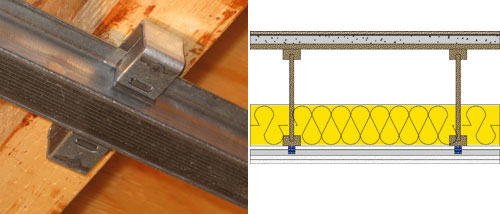Noise Control and Room Acoustics in Building Design
Sound isolation floors
Footsteps and impact noise can be intrusive to occupants in spaces below. Construction that calls for hard floor surfaces such as hardwood flooring, ceramic tile, quarry tile, marble, wood parquet, and vinyl tile are all areas where impact noise is of concern.
With no additional sound isolation system, a 6-inch concrete slab has an STC of 53 and an IIC of 27. With hard floor surfaces on the concrete, the floor system falls well below the UBC requirement of IIC 50 for multi-family type buildings. Adding properly engineered resilient materials in the middle of the floor/ceiling sandwich will increase STC and IIC.
Roll-out isolation material. One typical roll-out isolation system creates an airspace of one to four inches with resilient isolators spaced according to design criteria. The roll-out isolation material can be installed beneath a “floated” concrete slab or other built up floor system utilizing cross-laid plywood sheathing. Installed between concrete slabs, the assembly STC and IIC can be 72 and 62 respectively. These values surpass the performance of continuous underlayments due to the airspace and lower natural frequency created by the isolators. Applications include high performance noise control spaces such as dance studios, rooftops where flyover noise is an issue, noisy mechanical equipment rooms over classrooms, and more (see Galaxy Lanes Case Study). Any room where high levels of airborne or structure borne noise are created over an occupied space would be a candidate for this type of systems.
Low profile underlayment. While having lower STC and IIC values than 1-to 4-inch-thick pads and batting, low profile resilient underlayments are a lower cost material primarily designed to improve the impact noise rating (IIC).
Recycled rubber.One environmentally friendly noise control low profile floor underlayment is 98 percent post-consumer and post-industrial recycled rubber. A 3 mm underlayment beneath hard flooring and on top of a 6 in. concrete slab can achieve STC and IIC values of 50 each.
 |
Gypsum concrete, ¾ in. plywood, 14 in. I-joist and 6 in. fiberglass insulation plus sound isolation clips have an STC and IIC of 54 and 57 respectively. Image provided by Kinetics Noise Control |
 |
Saving valuable ceiling height, a wood-frame rubber and steel ceiling hanger is attached to 2 in. x 10 in. joists and suspends two layers Image provided by Kinetics Noise Control |









